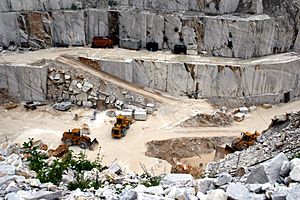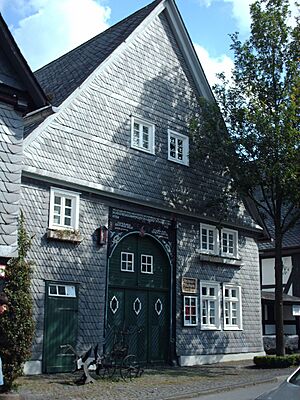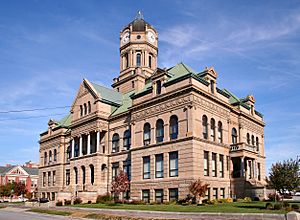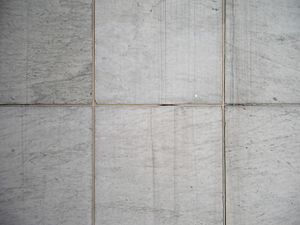Dimension stone facts for kids

Dimension stone is a special type of natural rock that has been carefully chosen and shaped for specific uses. Think of it as natural stone cut into exact sizes and shapes, like big blocks or thin slabs. People pick these stones based on their color, how they feel (their texture), their patterns, and how shiny or rough their surface is.
An important thing about dimension stone is how long it lasts. It needs to be strong, resist damage, and keep its good looks for a very long time.
Quarries are places where stone is dug out of the ground. Some quarries produce dimension stone, while others produce crushed stone (which is used for things like roads). A quarry can often switch between making both. To get dimension stone, workers use special, gentle methods like diamond saws or light explosives. This is because they need to keep the stone in large, unbroken pieces, unlike crushed stone which is just blasted into smaller bits.
Contents
Types of Stone and How They're Finished
Many different kinds of rocks are used as dimension stone. These include igneous rocks (formed from cooled lava), metamorphic rocks (changed by heat and pressure), and sedimentary rocks (formed from layers of sediment).
The most common types you might hear about are:
There are also other special types like alabaster (a type of gypsum) and soapstone (a type of talc).
Stones can have many different looks, called "finishes." These finishes change how the stone looks and feels:
- Polished finish: This makes the stone super shiny, almost like a mirror. It really brings out the stone's natural colors and patterns.
- Honed finish: This makes the stone smooth but not shiny, like a satin or eggshell surface.
- Brush-hammered finish: This creates a rough, bumpy surface with a uniform pattern, like a houndstooth fabric.
- Sandblasted finish: This makes the surface rough and pitted by blasting it with sand or metal particles.
- Thermal (or flamed) finish: This uses a very hot flame to create a rough, non-shiny surface. It might even change the stone's color a little, especially if the stone has a lot of iron.
Main Uses of Dimension Stone
Dimension stone comes in thousands of colors and patterns! These unique looks are created by natural things like tiny mineral pieces, veins, or streaks in the rock. Sometimes, even rare stones like jade or agate are used.
Here are some of the main ways dimension stone is used:
Kitchen and Bathroom Countertops
Stone countertops and bathroom vanities are usually made from large, finished slabs of stone. They are often polished, but can also have other finishes. In the United States, they are commonly about 3/4 inch or 1 1/4 inches thick. Sometimes, thinner slabs are glued together at the edges to make them look thicker.
Workers cut these slabs to fit perfectly on top of kitchen or bathroom cabinets. They use special saws, like diamond wire saws, which are very efficient. After cutting, the slabs are polished and sometimes sealed to fill tiny cracks. The stone for countertops is usually granite, but marble, limestone, or slate are also used. Most of this stone comes from countries like Brazil, Italy, and China.
You might have heard concerns about radon gas from granite countertops. The good news is that most radon in homes comes from the soil and outdoor air, not from building materials like granite. Only a tiny amount, about 2.5%, comes from all building materials combined.
Stone Tiles
Tiles are thin, flat pieces of stone, often 12 inches square and about 3/8 inch thick. Other popular sizes are 15, 18, or 24 inches square, which are usually a bit thicker. Most stone tiles are polished, but honed (smooth, non-shiny) tiles are becoming popular too.
Almost all stone tiles are made in factories using machines that cut and finish them to exact sizes. This makes them perfect for floors and walls. The stone for tiles is most often marble, but granite, limestone, slate, or quartz-based stone are also used. White and light earth colors are common. Italy and China produce a lot of stone for tiles.
Monuments
Stone monuments include tombstones, grave markers, and mausoleums. After being cut into large slabs, smaller saws or tools shape them. The front and back surfaces are usually polished. Then, individual monuments are carved and shaped using hand tools and sandblasting.
Today, granite is the most common stone for monuments because it's very durable. Marble is also used, especially in military cemeteries. In the past, limestone and sandstone were popular, but they don't last as long because acid rain can damage them more easily. Common granite colors for monuments are gray, black, and mahogany, while white is popular for marble. Much of the stone for monuments in North America now comes from countries like India and China.
Building Parts
Dimension stone is used in many parts of buildings:
- Veneer: This is a thin layer of stone used on the outside of a building. It's for decoration and also helps protect and insulate the building.
- Ashlar: These are squared blocks of stone, often brick-sized, used to cover walls, especially on the outside.
- Other shapes: Stone is also cut into rectangular blocks for stair treads (the part you step on), sills (under windows), and coping (the top layer of a wall). Parts that people walk on usually have a rougher finish to prevent slipping. Limestone is often used for these, but sandstone, marble, or granite can also be chosen.
- Roofing slate: This is a thin, shingle-sized piece of slate used for roofs. It makes a very long-lasting roof. Slate is also used for countertops and floor tiles.
Traffic and Outdoor Uses
Stone is also used for roads and walkways:
- Curbing: These are thin stone slabs used along streets or highways to separate sidewalks from the road. Granite is almost always used for curbing.
- Flagstone: These are flat, irregular-shaped stone slabs, sometimes cut into rectangles, used for paving walkways. Sandstone or quartzite are commonly used for flagstone.
Other outdoor uses include dry stone walls (built without mortar) and riprap (large stones used to protect against erosion).
To make sure dimension stone is good quality, there are special rules and tests. For example, the American Society for Testing and Materials (ASTM) has standards for different types of stone like granite, marble, and limestone.
Where Dimension Stone Comes From

The biggest producers of dimension stone in the world are Brazil, China, India, Italy, and Spain. These countries produce millions of tons of stone each year. Portugal also produces a lot of dimension stone.
The United States produces some dimension stone, but not as much as these major countries. For example, Portugal produces twice as much as the U.S.
Over the years, the demand for finished granite and marble has grown a lot worldwide. However, in recent years, the growth for granite has slowed down a bit, while marble demand has remained strong. Countries like Brazil, China, and India are becoming bigger players in the stone market, challenging traditional suppliers like Italy and Spain.
"Building Green" with Stone
"Green building" means constructing buildings in a way that is good for the environment. This idea has become very important because of rising energy costs and the need to save energy. Organizations like the U.S. Green Building Council (USGBC) have created systems like LEED (Leadership in Energy and Environmental Design) to rate how "green" a building is.
Dimension stone is a great choice for green building because it's a natural material. Making stone products uses much less energy and causes less pollution compared to making materials like steel, concrete, or plastic. Stone also has an advantage over artificial or synthetic stone products.
One rule in LEED is that stone used in a green building should come from a quarry within 500 miles of the building site. This helps support local stone producers and reduces the energy needed for transportation.
When old buildings are torn down, dimension stone can be completely reused! It can be salvaged for new buildings, used for paving, or even crushed for other uses. There are also new "green" ways to clean stone, like using special bacteria to remove dirt from old marble and limestone.
Stone's Lasting Power
Dimension stone is considered one of the most sustainable building materials. It comes directly from the Earth's bedrock, which is found everywhere.
- No toxic materials are used when processing it.
- It doesn't create direct greenhouse gases during processing.
- Dust and water used in quarries are carefully managed and recycled.
- It's a "perpetual resource," meaning there's a huge amount of it, so it won't run out anytime soon.
Dimension stone can last for many generations, even centuries! This means stone manufacturers don't usually need special recycling programs because the product itself lasts so long.
However, the color and pattern of stone can change slightly over time due to weather, especially if it's exposed to the elements. For example, some limestone might change from tan to a light yellow. Also, if there are cracks or weak spots in the rock, it might not be suitable for dimension stone. But usually, if one part of a quarry isn't good, another part will be.
Many quarries have been operating for over a hundred years, like the Barre granite quarry in Vermont or the Carrara marble quarries in Italy. While quarries do create some dust, noise, and water use, these can be managed to protect the environment. The land around a quarry can also be restored once the quarry closes.
Giving Stone a Second Life

Recycling dimension stone happens when old buildings are taken down. Specialists look for old houses, buildings, or bridges made of stone that are scheduled for demolition. They especially value old, hand-carved stone pieces or local stones that are no longer quarried.
Recycled dimension stone is used to fix up old stone buildings, for fireplaces, benches, decorative walls, or for landscaping.
Sometimes, an entire stone building is carefully taken apart, stone by stone. Each block is numbered and its exact position is noted. Then, all the stone is moved to a new location and put back together exactly as it was! This is very expensive and rare, but it's important for saving historic buildings.

Dimension stone is also reused when old buildings are renovated. Sometimes, only the outside (the facade) of a building is kept, and the inside is completely redone. The stone work often needs attention too. This might involve cleaning, fixing the mortar between stones, or replacing damaged pieces. It can be tricky to find an exact match for old stone, as its color might have changed over time, and even stone from the same quarry can look different. Luckily, sometimes the original builders saved extra pieces of stone for future repairs!
Choosing and Cleaning Stone
When picking dimension stone, first think about its color and how it will look in its surroundings. Remember, the same stone can look very different with a polished finish compared to a rougher one. A polished finish makes colors deeper and patterns clearer, while rougher finishes make colors lighter and patterns softer.
You also need to think about how the stone will be used.
- For countertops, you want stone that doesn't absorb liquids easily, resists stains, and can handle heat and impacts.
- Tiles should be sealed to prevent stains.
- For floors or walkways, you need a finish that isn't slippery, like bush-hammered or thermal. A glossy polished floor can be slick.
Cleaning dimension stone requires special care:
- Don't use abrasive cleaners on polished stone, as they will scratch the shine away.
- Don't use acidic cleaners on marble or limestone, as they will dissolve the finish.
- Textured finishes can handle some mild abrasive cleaners, but avoid bleach or acidic cleaners if the stone is marble or limestone.
- Stains (from food, grease, or metal) need special removal techniques, like using a "poultice" (a paste that draws out the stain).
Stone Finishes Up Close
Here are some common ways stone surfaces are finished:
- Polished finish: A very shiny surface that shows off the stone's true color and patterns.
- Honed finish: A smooth, non-shiny surface. This is often recommended for floors in busy places.
- Brushed finish: A smooth, wavy surface made by using stiff brushes on the stone.
- Thermal finish: A textured, non-shiny surface created by intense heat.
- Diamond sawn: The finish left by a diamond-toothed saw.
- Rough sawn: A rough surface left by a large frame saw.
- Bush-hammered: A textured surface made by hammering the stone with a special tool. It can be slightly rough or very rough.
See also
 In Spanish: Sillar para niños
In Spanish: Sillar para niños
- List of decorative stones
- List of types of limestone
- List of types of marble
- List of sandstones
- Stone carving
- Stones of India
- Spolia, also known as Repurposed building stone
|






